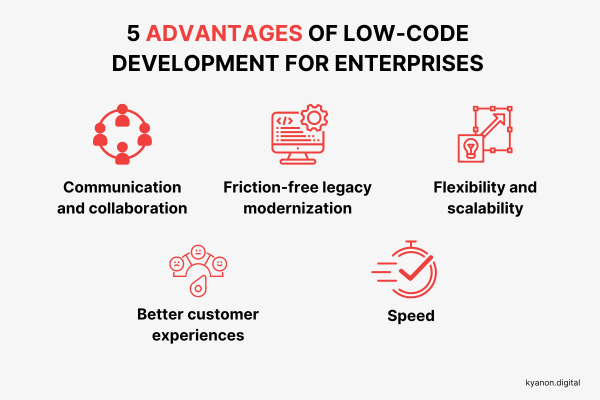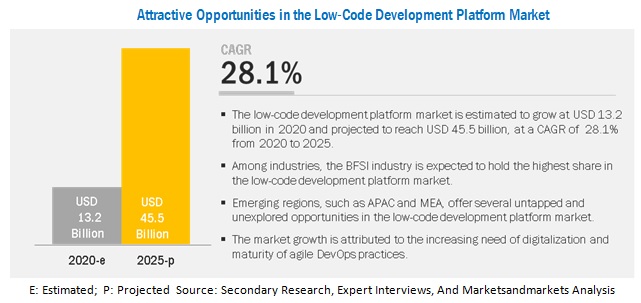Great Facts For Choosing Low-code platforms for application development
Great Facts For Choosing Low-code platforms for application development
Blog Article
Benefits Of Low-Code Application Development In Terms Of Accessibility For Non-Developers
The following main factors make low-code development available to non-developers.
Drag-and–Drop Builders : Low-code platforms provide drag-and-drop interfaces that allow people who are not developers, and without the requirement to write code to build visually-based applications. This makes it much easier for people who don't have technical background to participate in the process of development.
WYSIWYG: WYSIWYG editors are "What you See is What you get" editors that permit users to create workflows and interfaces similar to the final product. This makes it simpler to understand and use.
Simple logic and Workflow Design
Visual Workflow Design: Users are able to easily design business process and application logic using flowcharts, models and diagrams. They are simpler to work with than traditional coding.
Low-code platforms usually come with pre-built logic components (e.g. the conditional loops, statements), which reduce the need for complicated coding.
Reusable templates and components:
Library of pre-built templates: Many Low-Code platforms offer templates that are based on the most common types of applications. Non-developers are able to customize the templates as needed.
Reusable Widgets and Modules Users are able to use reused widgets. This allows for a simpler creation and eliminates the requirement for in-depth knowledge.
Guided Development Tutorials and Guided Development
Step-by-Step Instructions: Platforms usually provide tutorials on screen, guiding development pathways, as well as other tools to assist people who are not developers to create applications.
Interactive Tutorials Interactive and hands-on tutorials allow users to learn through doing. They can build confidence using the platform.
Integration with tools already in use:
Seamless Integrate: Low code platforms are designed to seamlessly integrate with existing tools and systems in business (e.g. the ERP or CRM) that permits non-developers to build applications that can work within existing workflows.
APIs Connectors: APIs integrate into applications to simplify integration. This allows non-programmers who don't have programming skills, to connect with external services.
Collaboration Features:
Team Collaboration: Features such as real-time collaborative workspaces, as well as shared workspaces allow for non-developers to collaborate effectively with developers, business analyst and other key stakeholders.
Access Control Based On Roles: Developers who are not developers can have access to roles and levels of access that allow them to contribute without compromising functionality or security.
Automated testing and debugging:
Built-In Testing Tools: Low-code platforms often include built-in testing and debugging tools to automate these procedures, making it much easier for non-developers to make sure the application is working properly.
Error Highlighting: When issues occur, the platform identifies the issue and offers solutions. It also guides users through troubleshooting.
The general rule is that low-code app development has the ability to democratize development. This is a major advantage for non-developers. Low-code platforms offer intuitive, visual tools, guided user experiences, and allow business users to actively participate in creating, maintaining and updating applications. Have a look at the most popular a fantastic read on Low-code Platform for application development for more tips including software for app development, app platforms, app platforms, azure sql databases, develop cross platform mobile app, develop web application, app modernization, application development platforms, low code development platforms, developing mobile apps and more.
Benefits Of Low-Code Application Development For Governance And Security
Low-code development offers many benefits regarding security and governance. These are crucial to ensure that applications are secure, reliable and well-managed through their entire lifecycle. Here are a few key benefits.
Unified Management console: Low-code platform usually provides a central dashboard where administrators can oversee and manage all applications, ensuring consistency governance across the organization.
Role-Based Access Control RBAC (RBAC). These systems typically provide robust access control by role, which gives administrators the ability to define and apply their own access rules. This allows only authorized users to modify or access certain elements of a program.
Compliance and Regulatory Adherence
Many low-code platforms include built-in compliance functions. They are built in line with industry standards, regulations and laws (e.g. HIPAA, GDPR). They offer frameworks and instruments to ensure that the applications are compliant with requirements.
Audit Trails and Logging Audit trails and logs that are comprehensive are often integrated, allowing companies to track changes, monitor access, and ensure compliance with internal as well as external rules and regulations.
Enhance Security Measures
Data encryption. Low-code systems offer encryption for information both in the state of rest and while it is being transmitted, which ensures sensitive information is kept safe.
Security Certificates: Many low-code companies have a security certificate (e.g. ISO 27001 and SOC 2) which demonstrate they adhere to the strictest security standards. They offer an additional security level to their clients.
Automated security updates:
Regular security updates and patches : Low-code platform handle automatically security updates, patches and updates. Thus, applications are protected from current threats without requiring manual intervention by developers.
Security Monitoring Tools: These tools give alerts in real time and insight into potential security problems.
Data Governance
Data Access policies: These platforms help organizations determine and apply their policies on data access, ensuring only authorized users are able to access information and that it's correctly used.
Data Masking and Anonymization Built in tools to mask and anonymize data safeguard sensitive data, particularly in testing environments and development environments.
Consistent Application Management
Development and deployment pipelines Low-code platforms provide integrated development, including security checks. This ensures security throughout the lifespan of the application.
Version Control: An integrated version control facilitates the control of changes. It also ensures that any changes made to the software are tracked, and if needed reversed. This ensures the integrity of the software.
Authorization and Authentication of Users:
Single Sign-On (SSO): Support for single sign-on as well as other advanced authentication mechanisms simplify management of users and improves security.
Multi-Factor Authentication (MFA) A number of platforms offer built-in support for multi-factor authentication, adding an additional layer of security to access applications.
Monitoring Policy Enforcement
Policy Templates: Low code platforms typically have templates for governance and security that enable organizations to quickly apply policies.
Compliance Monitoring Tools - These tools permit continuous checking of compliance status and provide reporting, making it easy to identify and resolve potential issues.
Integration into Existing Security Infrastructure
Seamless Integration: Low-code platforms have been designed to work with current security tools and infrastructure, such as identity management systems SIEM (Security Information and Event Management) solutions, and firewalls.
API Security: API integrated security guarantees that integrations with other systems are secured. Protect data and maintain the consistency of your application.
Training and best Practices
Best practices guides: A lot of platforms provide guidelines and recommended procedures for the creation of secure applications. These help non-developers meet security standards.
Certain lowcode companies offer assistance and security training to users to help them understand how they can build and maintain secure applications.
In general, low-code developers offer security and governance advantage that allows them to build and manage their apps in a controlled, compliant and secure manner. These platforms offer all the tools and frameworks required to safeguard sensitive data and enforce policies, while ensuring regulatory compliance. Have a look at the top rated wavemaker.com coding for blog tips including develop cross platform mobile app, azure sql server, cross platform mobile development, multiplatform mobile app development, driver jdbc, build a docker container, app platforms, microsoft azure sql, lowcode no code, lowcode no code and more.
Advantages Of Low-Code Application Development In Terms Of Collaboration And Workflow
It's a great option for companies that wish to improve team efficiency, streamline processes and improve collaboration. Here are some key benefits.
Unified Development Environment Low-code platform provides a single unified environment, where all employees such as analysts, developers, designers, stakeholders and other stakeholders, can easily collaborate. This helps eliminate silos and encourages better communication.
Visual Development Tools: Low-code platforms are easy to use, and come with an interface that allows drag-and-drop. This lets non-technical people on the team to take part in the process of development and ensures that business requirements can be captured accurately.
Communication Enhanced
Real-Time Collaborative Features: A lot of platforms using low-code have real-time collaborative capabilities, which include simultaneous editing, comments, and instant feedback. These tools facilitate communication and reduce time spent discussing back and forth.
Shared Workspaces: Teams may collaborate in shared workspaces in which they can review, edit and discuss aspects of projects, ensuring that everyone is on the same page and working towards the same goals.
Workflow management simplified:
Project management tools that are built-in Low-code platforms are often equipped with project management tools integrated that let teams plan, track and manage their projects. This includes the management of tasks, tracking progress and management of deadlines.
Workflow automation: Automating routine workflows and activities decreases mistakes and manual labor that allows individuals and teams to concentrate on strategic projects and increase efficiency.
Speedier Iteration cycles
Rapid Prototyping Low-code platforms are perfect for rapid prototyping. Iterative development is also feasible which allows the team to experiment, create and refine their applications within shorter time. This allows feedback to be quickly implemented, and changes can be made.
Agile Development Support The support for agile methodology allows teams to be working in sprints, constantly offering small increments of functionality. This makes it easier to adjust to the changing needs.
Accessibility to non-developers
Citizen Development: Low-code platforms allow business users (citizens developers) to build and modify their applications without any prior knowledge of programming. This reduces the burden on IT teams and developers, enabling them to react more quickly to the demands of business.
Training and Onboarding - Simple interfaces, comprehensive training resources and intuitive interfaces make it easier for new team members get familiar with the system and boost the overall team's collaboration.
Centralized documentation Knowledge sharing, dissemination and centralization:
Documentation is integrated: Low-code platforms are often equipped with features to create and manage documentation on the platform, making it easy for all project information to be centralized.
Knowledge Repositories: Teams can develop and maintain knowledge repositories that include best practices, templates, and reusable components, which aid in knowledge sharing and reducing repetition of efforts.
Standardization and Consistency:
Standardized Components: The use of already-built, standardized components gives the sameness between the different applications. This makes it simpler for members of the team to comprehend the various components of a given project and to work on them.
Governance and Compliance - Built-in governance frameworks ensure that the development process of all applications adheres to organizational standards as well as regulatory requirements. This reduces risks of non-compliance as well as ensure that applications comply with the highest quality standards.
Feedback loops:
Integrated Feedback mechanisms: Low-code platform typically have a built-in feedback mechanisms that allow users to easily give feedback on applications. Feedback can then become integrated into the development.
Continuous Improvements: The ability for applications to iterate quickly and make changes on the basis of user feedback, making sure that they are in tune with the requirements of the user as well as business goals.
Visualization of Reporting:
Real-time Analytics: In-built analytics and reporting provide real-time information about the project's performance, user interaction and progress. Data-driven decision-making is possible.
Visual Workflow Maps Software for mapping workflows or processes are useful to teams in understanding their processes. They also help to identify bottlenecks, and areas that need improvement.
Low-code development offers many benefits in terms of workflow and collaboration. It allows for the integration of diverse teams together, improve processes, improve communication and improve collaboration. This helps create a more agile, efficient and collaborative environment for development. This eventually results in better-quality applications and better alignment of business objectives.